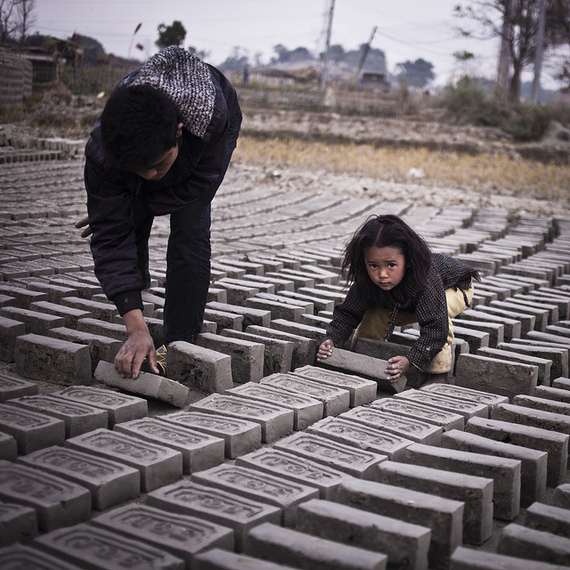Bipana Tamang, 4 years old, helps her dad turn bricks to dry in the sun. Photo credit: Alice Carfrae (c) Legatum Limited 2015
Impact measurement is at the top of the agenda right across the philanthropic sector. Every organisation wants to be able to measure its impact, both because that's the only way to truly learn, and because a new breed of business-minded donors are asking hard questions about what is being achieved with their money.
The mission of the organisation I lead, the Freedom Fund, is to mobilize the capital and knowledge needed to end modern slavery. Measuring our impact is critical to our success, because one of the key ways we attract new investors is by showing evidence of our past performance.
The fight against modern slavery brings some unique challenges to measuring impact. Slavery is nearly always hidden, in brothels, in backstreet factories, in private homes. For our newly-launched Thailand hotspot program, where we are investing $5 million over three years to combat slavery in the seafood industry, we are dealing with a crime that takes place hundreds of miles out to sea, among migrant workers forced to work on fishing boats. That presents real obstacles to getting accurate data about the size of the problem and tracking progress.
A further challenge is defining success. One of the Freedom Fund's key metrics is how many people we are able to liberate from slavery. In 2014, for example, our programs liberated 2,193 men, women and children from bondage in India. This is a magnificent achievement and one that we are able to measure accurately, but it represents a narrow slice of the work that we support. Many of our partners focus on longer-term prevention measures, because rolling back slavery is as much about stopping people from falling into it as it is about bringing people out. This means building up the resilience of the most vulnerable families, through education, jobs training, and community organizing.
This work is vital, but it does not lend itself to easy measurement. In other development sectors, like health, desired outcomes can be tested in a straightforward way. How have malaria infection rates dropped? How has child mortality decreased? What the Freedom Fund is interested in is how prevalence of slavery has diminished over time, but the link between our prevention activities and the number of people in slavery is harder to establish with certainty.
The same goes for our efforts to disrupt the underlying systems that drive slavery. We complement our work at the community level -- the "bottom-up" approach -- with top-down efforts to influence government policy, bring about new legislation, and push multinationals to clean up their supply chains. In Thailand, we'll be supporting media coverage of the slavery issue to keep the international spotlight on the Thai government and the European and American supermarkets that import Thai seafood. But with this type of work, it is rarely possible to draw a straight line between cause and effect.
The Freedom Fund has responded to these challenges by adopting a variety of measurement methods. We have worked with Geneva Global, our implementing partner, to establish a comprehensive data collection system that pulls in information from our partners on 20 global metrics. This provides us with an overall picture of our reach, our partners' outputs, critical outcomes such as rescues and convictions of traffickers, and the cost of doing this work. We receive this data each quarter and can post it immediately on our website. As of the first quarter of 2015, for example, our programs had liberated an additional 727 people, put over 8,000 at-risk children in school, helped 5,000 vulnerable people start micro-businesses, and provided legal assistance on over 300 trafficking cases -- at an average cost of $21 per person. By the end of this year, we will have data coming in from six hotspots and over 60 partners.
But to get to that next level of analysis -- how have these activities affected the scale of the problem -- we need to go further. That is why we are partnering with leading academic institutions to help us establish the "so what?" What happens to families whose children attend school instead of working full-time? What happens when communities are better organized to protect themselves from traffickers? In the coming months, our first study, with Harvard University, will publish its findings on a very promising program run by one of our partners in Uttar Pradesh. Further studies by the Institute for Development Studies and the London School of Hygiene and Tropical Medicine are in the pipeline.
In some cases, we will need to use proxy measures. It's unlikely that we'll ever be able to count the number of forced labourers on Thai fishing vessels and see how this is changing over time. But there's a lot we can do to see if our program is having an effect. We will track whether our funding of legal aid for migrants is leading to more prosecutions of traffickers and more civil compensation cases. We will survey migrant workers in the ports, whose networks extend to the boats, to monitor their perceptions of the scale of the problem and the availability of support services. And we will talk to policy-makers and company executives to understand what factors are influencing their decisions. Ultimately we will be able to build up a strong picture of what is happening in the Thai seafood industry and whether our program is having the intended effects.
In many ways, the Freedom Fund sees the challenge of impact measurement as an opportunity. The lack of existing data about the scale of the problem, and the need for more rigorous evidence about what anti-slavery strategies work, mean that we can make a significant contribution by documenting and sharing what we learn from our growing portfolio of programs. For all of us at the Freedom Fund, the opportunity work on ending the scourge of slavery is a tremendous privilege.
Nick Grono (@nickgrono) is the CEO of the Freedom Fund. This article featured in What We're Reading, a weekly newsletter by one of the Freedom Fund's founding investors, Legatum. To receive future editions of What We're Reading, sign up here.

